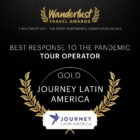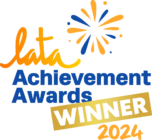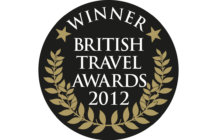South America’s last frontier

As the 226m high wall of thundering water slid into view underneath the tilted wing of the eight-seater Cessna, my vice-like grip on the armrest loosened for the first time in two hours. With that sight, my fear of flying melted away.
Kaieteur Falls is hidden amongst an endlessly undulating carpet of lush forest spliced with rivers of emerald water. It plummets from a semicircular sandstone shelf, high in the Pakaraima Mountains of Guyana. So remote is its location that it was not until 1870 that the falls were first seen by a European: the British explorer, Barrington Browne. Five times the height of Niagara, the scale and beauty of the falls are breathtaking.
We landed on a dusty airstrip and walked through thick jungle to the top of the falls. Leaning precariously over a rock lip we watched as swallows darted through the spray and the dazzling refracted rainbows. The drop becomes ever more dizzying when you learn the origin of the name. Teur means ‘falls’ in the local dialect and, according to Patamona Indian legend, Kai was a chief who paddled over the falls to his death in order to appease Makonaima, the Great Spirit, and save his people from the Caribs. Kaieteur for me sums up the thrill of the Guianas: remote, unexplored, overflowing with wildlife and geological wonders.
Guyana and Suriname (formerly British Guiana and Dutch Guiana respectively) receive less than 2,000 tourists each year. The region, a melting pot of ethnic diversity, is unlike any other part of South America. Here, Latin America meets the Caribbean, with an intriguing mix of Afro-Caribbean, Amerindian, European and Asian influences. This blend of cultures is most obvious in the capital cities of Georgetown (Guyana) and Paramaribo (Suriname) where mosque, synagogue and wooden clapboard cathedral sit comfortably beside one another, while both food and music are a thrilling fusion of Indo-Caribbean traditions.
Cultural blends are also present in the interior of Suriname. At Palumeu village, which hugs the banks of the tannin-rich Tapanahony River, the Trio and Wajana Indians live peacefully together, despite the difference in languages. The craftsmanship and skills necessary to make a living from the jungle were in full evidence as we wandered through the village. We passed one man who was fashioning a spear of striped letterwood using a vicious looking peccary (native wild boar) jaw. His wife was seated beside him grating cassava roots before washing and vigorously squeezing the resultant bitter mush in a woven reed tube. Cassava is a vital and adaptable foodstuff used for making bread, pepper pot (fiery stew) and beer.
Further along the riverbank, two men were chipping away at an enormous felled tree trunk. They stopped working to explain how it will take them two months to shape and stretch this wood into a 10-metre-long dugout canoe to fish the rivers for delicious sweet Arapaima, the largest freshwater fish in the world. From Palumeu we flew to Awarradam. This tranquil jungle resort is on a secluded river island, 225km from Paramaribo and surrounded by opaque orange-coloured rapids. Close to Awarradam are the Saramaka, the largest community of Maroons in Suriname. The Maroons are descendants of West African slaves who fled from their lives of slavery on Suriname’s sugar, timber, and coffee plantations in the 18th century.
As we approached the village entrance on the banks of the river, a fringe of palm leaves was hanging at head height from a post. Our guide explained to us that the Saramaka use these leaves to cleanse guests to the village of bad spirits, trapping the malign spirits on the village boundaries. Consultation with animal spirits and dead ancestors is an everyday occurrence in Saramaka villages. The fascinating West African culture is more intact here, in the heart of Suriname’s jungle, than in the areas where the slaves originally came from. The Saramaka have an oral tradition, rich in historical stories and prayers and on our final visit there, the whole village gathered to teach us some of their songs and infectiously energetic dances. We returned to Awarradam by canoe, still singing, guided by a huge and heavy moon.
Beyond the populated centres of the Guianas, the impenetrable forest interior remains almost untouched. Guyana and Suriname are developing eco-tourism projects such as the Iwokrama International Centre for Rainforest Conservation and Development to protect the region. This programme safeguards one million acres of pristine rainforests and its indigenous communities, whilst allowing the tourist to share in Iwokrama’s incredible beauty.
For wildlife, the Guianas are unrivalled. This little-known corner of the Amazon basin has rainforests that are brimming with jaguars, giant otters, tapirs, giant armadillos, and over 800 bird species. An impressive canopy walkway, 30 metres above the forest floor gives the perfect vantage point for bird watching and jaguar spotting.
But to get up really close to the animals of Guiana we visited Karanambu, a 125-acre (50 hectare) ranch in the Rupununi savannah and was the home of Diane McTurk, world-renowned for her work rehabilitating orphaned giant otters. Karanambu has drawn many visitors of note in decades past, including Gerald Durrell and Richard Attenborough.
Diane is elegant, sprightly and extremely hospitable, evoking a more graceful and glamorous era, with her charming clipped vowels. As she towel-dried the noisy and boisterous otter cubs after their afternoon dip, she talked to them as one would to a mischievous child. "You naughty bug, come now, my love," she cooed, "You know you’re not supposed to chew me."
Though adorable, the otter cubs are not the only attraction at Karanambu. A boat trip through myriad lagoons and bow lakes is a wildlife enthusiast’s dream: troops of brown-bearded saki and red howler monkeys swing through the canopy, caimans bask on sand banks and knots of tree boas hang from the low branches. The river is alive with a thousand types of bird, tiger herons, jabiru storks, amazon kingfishers and colourful macaws that zigzag in front of the prow of the boat. Karanambu, like everything else I experienced in my brief visit to the Guianas, etches itself, indelibly, upon the memory.



























